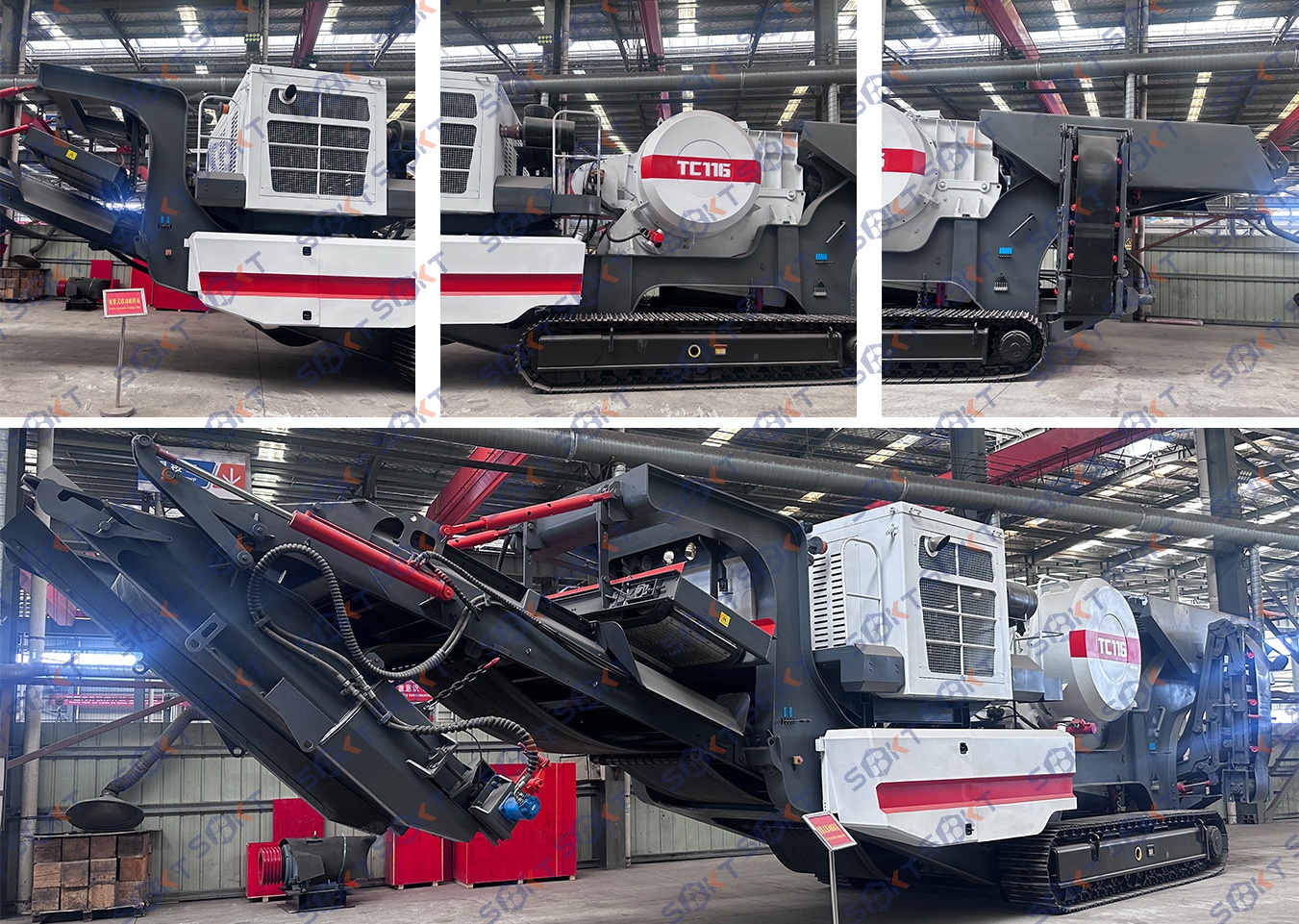
Which construction material crushing equipment is best? Which construction waste crushing equipment should I choose? The answers you need are at the end of this article.
1. Mobile Crushing Station
Advantages:
Flexible Mobility: Can be moved to different construction waste sites, making it particularly suitable for dispersed construction waste, reducing material transportation costs and secondary pollution.
Integrated Functions: Integrating feeding, crushing, screening, and conveying functions into one unit simplifies the operational process, eliminates the need for complex infrastructure, and allows for rapid commissioning.
Environmentally Friendly: Equipped with dust removal and noise reduction systems, it effectively reduces dust and noise pollution, meeting environmental requirements.
Disadvantages:
Relatively Small Processing Capacity: Compared to large fixed equipment, the processing capacity of a single mobile crushing station is typically lower, typically ranging from tens to hundreds of tons per hour.
High Equipment and Operating Costs: The equipment itself is expensive, consumes fuel or electricity during movement, and has relatively high maintenance costs.
Application Scenarios: Suitable for dispersed construction waste disposal sites in cities, such as those in the renovation of older residential communities, road repairs, and temporary construction waste disposal projects.
2. Jaw Crusher
Advantages:
Large Processing Capacity: High throughput, capable of handling large amounts of construction waste, making it suitable for large-scale construction waste disposal projects.
High Reduction Ratio: Can crush large pieces of construction waste into smaller particles, resulting in a fine product size that meets diverse production needs.
Stable Operation: Simple and robust structure, high reliability, easy maintenance, and long-term stable operation, minimizing equipment downtime.
Disadvantages:
Relatively coarse output particle size: While it can produce fine particles, the output particle size may not be ideal compared to some specialized fine crushing equipment, potentially requiring subsequent secondary crushing or screening.
Noise and Dust: The crushing process generates considerable noise and dust, requiring appropriate noise reduction and dust removal equipment.
Applications: Commonly used for coarse and secondary crushing of construction waste, capable of handling construction waste of various hardnesses, such as concrete blocks, bricks, and stones.
3. Impact Crusher
Advantages:
High Reduction Ratio: Can crush construction waste into smaller particles, offering high throughput and effectively improving crushing efficiency. Good Product Shape: The crushed product particles are well-shaped, mostly cubic, with low flake content, which improves the quality of recycled aggregate and is suitable for applications requiring high aggregate particle size.
Selective Crushing: Selective crushing effectively separates the different components of construction waste, improving the purity of the recycled aggregate.
Disadvantages:
Limited Impact Resistance: Hard and tough construction waste may cause significant wear on the hammers and impact plates, requiring regular replacement of wearing parts.
Unsuitable for Wet Materials: When handling wet construction waste, clogging may occur, affecting crushing results and production efficiency.
Applications: Suitable for processing construction waste with medium to low hardness, such as discarded bricks and concrete blocks. Commonly used in the secondary and fine crushing stages of construction waste crushing production lines.
4. Hammer Crusher
Advantages:
High Crushing Efficiency: Utilizing high-speed rotating hammers to impact the material, the crusher achieves high crushing efficiency and can reduce construction waste to a small particle size in one operation. Screening Function: Some hammer crushers are equipped with a screening device, allowing them to perform both crushing and screening, reducing the need for subsequent equipment.
Strong Ability to Handle Wet Materials: Requires a low moisture content, can handle construction waste with a certain humidity, and is less prone to clogging.
Disadvantages:
Rapid Hammer Wear: Due to the high-speed rotation of the hammers, they directly impact the material, causing rapid wear and requiring regular hammer replacement, increasing equipment maintenance costs.
Uneven Product Particle Size: The crushed product has a relatively wide particle size distribution and may require further screening and grading.
Applications: Suitable for processing medium-hard, non-corrosive, and large-volume construction waste, such as discarded concrete blocks and bricks. It can also handle organic matter containing moisture and oil, as well as fibrous materials.
5. Cone Crusher
Advantages:
High crushing ratio and high efficiency: The material is squeezed from the mortar wall to the crushing wall, resulting in a more uniform finished product particle size. It can handle construction waste of higher hardness and offers high production efficiency. Stable Operation: Utilizing a static pressure principle and secondary vibration isolation, the equipment exhibits minimal vibration, ensuring stable and reliable operation and continuous operation.
Adjustable Product Particle Size: A hydraulic closed-side adjustment mechanism allows for convenient and rapid adjustment of the crusher’s discharge opening parameters, thereby controlling the product particle size.
Disadvantages:
Complex Structure: The equipment’s relatively complex structure makes maintenance and overhaul challenging, requiring specialized technicians for operation and maintenance.
High Price: Cone crushers are relatively expensive due to their high manufacturing costs, resulting in a relatively high initial investment.
Applications: Commonly used for secondary and fine crushing in construction waste management, it is particularly well-suited for applications requiring high product particle size and the production of high-quality recycled aggregate, such as aggregate for high-strength concrete.
In conclusion, there is no single optimal construction waste crushing equipment; selection depends on a comprehensive consideration of factors such as project requirements, budget, and site conditions. If you have a large processing capacity and a fixed site, consider using a fixed jaw crusher or impact crusher in combination. If you need flexible mobility, a mobile crushing station is more suitable. For hard construction waste, a cone crusher may be a better choice. Hammer crushers have certain advantages when processing wet and medium-hard materials.
If you have further questions, please contact Shengbang Machinery via WhatsApp at +8613949025317 for consultation!
Fill in the information and we will contact you as soon as possible